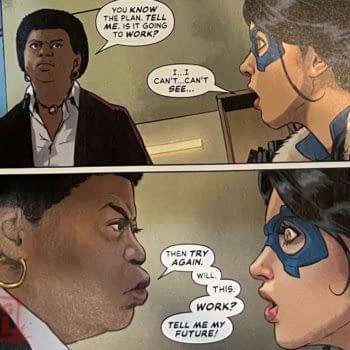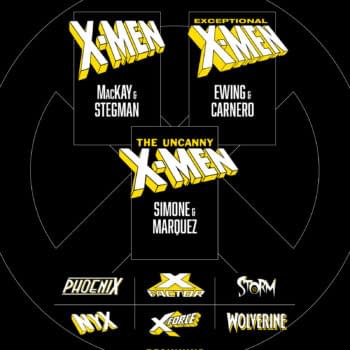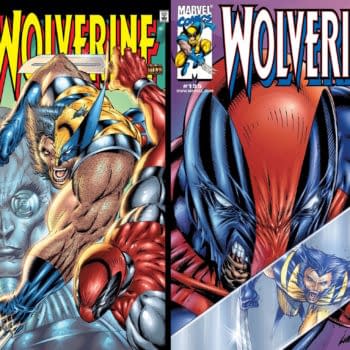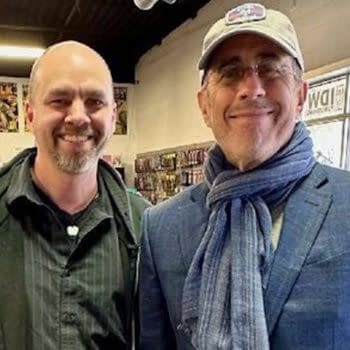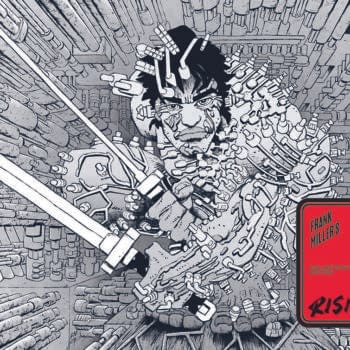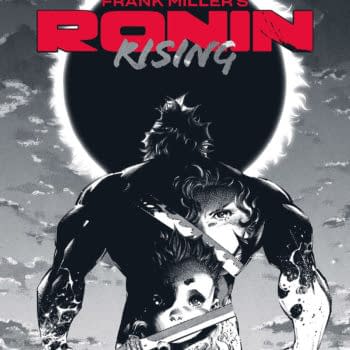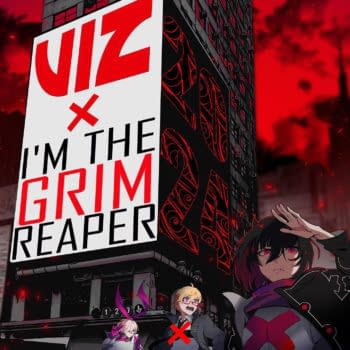Posted in: Comics | Tagged: Comics, dc, dc comics, entertainment, jh williams iii, sandman, sandman overture
JH Williams III Talks To Bleeding Cool About Sandman Overture
This past Saturday, the Cartoon Art Museum in San Francisco began displaying J.H. Williams III's original art from Sandman: Overture as part of the museum's ongoing Grains Of Sand: 25 Years of Sandman original art exhibition. I sat down with The inimitable Mr. Williams before his gallery opening and got the inside scoop on what's been going on with him and Neil Gaiman inside The Dreaming.
But before we get to the interview, I want to highlight a couple interesting tidbits from the talk he gave for the exhibitions opening.
First and foremost, if you live anywhere near the Bay Area you have to go check out this exhibit. Curator Ryan Graff did a phenomenal job collecting original Sandman artwork from literally every single artist that worked on the book. The collection contains original Dave McKean covers, Yoshitaka Amano paintings, Sam Keith pages from the very first issue with hand-pasted Todd Klein, the type-written original first issue script from Neil Gaiman, and of course, the new work from Williams – including unreleased pages from the second issue. Believe me when I tell you: they are gorgeous, and even more impressive than what he did in the first issue.
At the talk, Williams had a lot of interesting things to say about the internal workings of Overture such as the fact that it takes him roughly one week to do a double page spread for Sandman, and that level of quality is not something he or Neil are willing to compromise.
Once his work on Sandman: Overture is finished, Williams is going to start doing creator-owned work. "It really is the future of the industry," he said, "and I'm a big supporter of this new creator-owned surge in comics right now." I asked him which publisher he would be working with, but – to absolutely no one's surprise – his answer was, "I can't really talk about that right now."
Anyway, before all of this I had a great conversation with Williams over dinner about Sandman and many other things. It was an absolute joy to do, and I hope you enjoy it as much as I did.
David Dissanayake: So tell me about how this gallery of your Sandman work came together?
J.H. Williams III: Essentially through Ryan Graff. He was contacted from the museum in order to do this anniversary showing – an extended exhibit – of Sandman through the years. I've known Ryan for a long time, and since I'm doing new stuff he reached out to me and asked if I would participate, and I said sure and offered everything I could.
DD: You're a good deal into Overture now, so what are your feelings about the project and how things have gone so far? Are you happy with it?
JHW: Yeah, I am. It's always a tricky thing though, because you're always hoping you're doing the right thing for the project or whatever the scene is, so there's always that situation where you're wondering if this is coming out the way you hoped it would or thought it would. There is never that feeling of comfortability, but I think that is a positive thing. It keeps you on your toes and making sure you're thinking things through.
DD: I don't know how far along you are with the artwork – I know the second issue is finished – but the first issue is out in the wild now. Are you happy with how that came out?
JHW: Yeah, I think it came out really well. And you know as with anything after the fact you see in hindsight things you could have done better or you thought of something else afterward that you thought would have been cool. But overall the results I think are pretty cool. The printing qualities are nice and stuff like that.
I think the most interesting thing for me is making sure it feels like it is part of Sandman. Even though it's a prequel, and this is where things got tricky, where we thought what are we going to do – and what am I going to do – that I felt really worked because it needed to be a prequel but at the same time it needed to feel very now, without losing touch with it being a prequel. So it was this weird thing going, this push and pull, from my side.
DD: How do you find that balance, you think?
JHW: I don't know. I just kind of kept going and doing what I wanted to do. I guess I always just wanted to make sure that even whatever we're doing with modern techniques and modern print technologies and stuff like that, that it still felt like Sandman.
DD: You've worked with pretty much every single one of the greatest modern comics writers.
JHW: Yeah, I've been very fortunate.
DD: Well I'm wondering what is it like now working with Neil Gaiman in comparison to your previous collaborators. How is he different? What are his scripts like, and what is the interaction like between you two?
JHW: When we speak on the phone or exchange emails he's extremely enthusiastic about what I'm doing. When I hear his voice there is a lot of warmth that comes from him. He's very trusting about what I'm bringing to the table.
As far as a comparison to other people I've worked with, or his scripts versus other scripts… Every writer sort of has their own thing, even if their following a similar format as far as the technique goes. Neil, to me, feels more fluid like we're floating along to discover what the story is. That's what it feels like to me, and it would make sense that his scripts feel that way when you're reading them because the stories feel like that when you're reading Sandman. I thought that was kind of interesting.
As a logical comparison between him and my time with Alan Moore – since I worked with Moore for six years – Alan's scripts are very dense, and though he might not know exactly every detail of where he's going, you always feel like there is a much more purposeful sense of orchestration, where Neil feels almost like he's discovering as he's writing. Alan feels like, to me, and I could be completely off base here, but to me feels like he's already discovered, and now he's going to present the story, if that makes sense.
DD: Yeah absolutely. Does Neil give you a full script?
JHW: Yeah, I really need that. I'm one of those types of artists where I feel like I need to know what the characters are saying and feeling because I feel it all plays a role in how I set up my page or design a scene or how the characters act between each other. Definitely a full script.
DD: Is there a general outline for where Overture is going, or is this a complete journey of discovery?
JHW: I don't know. I think he knows. Well, he does know where its going and what the point is going to be, but I don't know if he knows concretely how we're getting there and every facet. I don't know that information. I haven't seen any private notes from him, I've just seen the scripts or the things we've talked about over the phone.
I think there are little diversions along the way. There's a thing coming up in issue 3 where something I had done or said to him that inspired him to write something in particular that centered around this idea we had during conversation. I think he knows the overall big plot, but the little pieces and how the connect and weave in and out of each other I think he's still figuring out. It feels to me like we're still moving through it.
DD: Well that actually sounds like a lot of fun to be doing something like that, going on such an interesting journey with Neil.
JHW: Yeah, definitely.
DD: So he sends you the scripts, and you illustrate it page by page. Is there a back and forth between you? Do you send him the page when you're finished and get feedback?
JHW: A little bit. Essentially, he's really trusting me to do what I do. What's interesting for me and my work process, even though I'm so design heavy in a lot of ways with how I tell a comic story, I don't tend to think those things through solidly beforehand. I do what feels right at the time.
When I got the first issue's script, because I hadn't really worked with Neil Before, I did something I've never been done before where I went through his script and started putting notes in the script in red where I put my thoughts about what he wrote and what I thought could be cool visually.
So I did that and then I sent it to him so he could see where my mind was going. But then for the scripts for issues 2 and 3 I'm not doing that. I'm just giving more of a generality and broad strokes visually. But then when he sees the pages he's been nothing but enthusiastic. Then after Neil the pages go to Dave Stewart for coloring.
DD: And you've been working with Dave for a while right?
JHW: Yeah. I've worked with Dave for a very long time. The first thing we did together was a short story for Humanoids Publishing and [Alejandro] Jodorowsky was the writer. It was a little ten page story, and then after that we kept making sure we worked together, and now that's it, he's my colorist.
DD: I was reading an interview with Neil Gaiman and he mentioned that he had thought he had given you impossible drawing challenges, like drawing Morpheus as a flower or as a building, and didn't expect it to be possible, and then when he got the drawings back from you he was intimidated and felt he had to step up his writing to keep up with your drawing. What was it like to hear that from him?
JHW: He's been extremely gracious with some of his remarks in that regard, but for me I'm just doing what he's asking to be done for the story to the best of my ability. I remember when he had first talked about the flower scene. He had sent me that scene, the first five pages of the first issue, and that was the first thing I saw before he sent anything else. It wasn't completely formatted or anything like that, he just sent it and asked "what do you think," you know, and he asked me "could this actually be done?" I said "sure," you know. What else am I going to say to Neil Gaiman [Laughs], "no it can't be done, I'm not even going to try!"
But you know, I was excited that he was happy. But when I look at that scene there are certain aspects I'm really happy with and then there are others where I think it could have been handled better in some parts and details, but I am that way with every page I do. As long as he felt it captured what he was after.
DD: Can you tell me a little bit about when you first started reading Sandman? When you look back now that you're on the book, what do you think?
JHW: Yeah, it's kind of weird to be involved in Sandman of all things is crazy cool because when that series first starting coming out… Well, I've always read tons of different kinds of comics, but at the time things were very superhero driven, very similar to how they are now, in that it's sort of the continuing trend, but you get to a point when you're a longtime comics reader and you've been reading superheroes from a young age, you end up at a natural evolution where you come to a point where you need something more, something else. Sandman came along right at that time for me.
I had always been exposed to a variety of comics so I was more open minded to it anyway, but when Sandman came along I just said, "Oh, I've got to try that." It came right at the perfect time to get extremely invested in something like that. And there were other things at that time like Hellblazer and all these great titles come that are from that period. Sandman was one of things that I gravitated towards like many other readers because it wasn't like anything else that was being done at the time.
Mentally I think it prepared me, before I started being able to do this stuff as a creator, it helped mentally prepare me for things like when I did get Promethea and stuff like that. My exposure to that kind of work helped because my previous exposure to Alan Moore was mainly his superhero stuff. There was his other stuff too, but at the time it was Watchmen, Watchmen, Watchmen. Sandman prepared me to tackle something like Promethea.
Sandman is a very influential series, there's just no denying it. I think it just came along at the right time. There wasn't anything like it and it inspired many other things. It wasn't necessarily an influence on what Alan did with Promethea, but I remember Alan quoting the cultural significance of what was going on with Sandman when we first began that book.
DD: As someone who grew up reading comics, and now having worked with all of these incredibly important writers, do you ever stop and freak out a little bit as a fan?
JHW: Oh yeah. I mean, everything is very professional, of course. You kind of have to be. But at the same time, I have to step back and go, "What the hell? What did I do to get this list of people who have worked with me?" I don't know. Maybe it's that I have such an appreciation for these writers myself. Maybe the universe is saying "We know you love these guys, and we're going to get you to work with them." I don't know.
Even though I am working with them and it's all professional, it also still feels like an honor to work with them, you know what I mean? Not just as a fan, but from one creator to another. I can relate to them now at that level.
DD: Can you tell us a little about what you're reading and listening to these days?
JHW: Well right now I just started reading a novel by R. Scott Bakker in the series he does called The Prince of Nothing. I just started the first book called The Darkness That Comes Before. I'm about a hundred pages into it and it's really, really good. It's world-building fantasy stuff that touches on big theological themes in a very strong way. Within the first hundred pages they're already having a holy war, and crazy stuff like that.
As far what I'm listening to, the thing I'm most excited about that I just ordered is Iggy Pop did a song with this band called the Zig Zags and it's a cover of someone called Bety Davis. It's not the actress, and I'm not familiar with who this Bety Davis is. I need to research it, but it was on Sirius Radio and it was so awesome I looked it up and it's on some small record label and you can order it on this small green vinyl 45 7-inch, so when I saw it, I just was like, "DONE! SOLD!"
I'm also really excited about the new Dum Dum Girls record. Everything I've heard off of that has been stellar.
DD: What comics are you reading? Are there any up and comic artists that have caught your attention?
JHW: One of the things I read just recently that really jazzed me was a graphic novel called Buzz from Oni Press, and it's about this alternate near future where spelling bees are outlawed so there are these back alley, fight club style spelling bees and it's so inventive! The artwork serves as this thing where as their spelling out the words it's like a battle with the words and the lettering becomes 3D and part of the artwork and it's like their power to spell us a superpower and it's amazing, amazing stuff.
I also read Red Light Properties by Dan Goldman. It's ridiculously good. I also read Bad Machinery, also by Oni Press. What's weird for me that both of these are print versions of online comics, and I don't ever read online comics. It just that with that format I just have a hard time being able to read in that way, and now these companies are doing these nice publications of that stuff and its interesting.
DD: Yeah I've seen those in the shops, but I haven't picked them up yet, but I'll have to do that soon. Finally, if you had to pick one, who would be the member of the endless that is your favorite or who you relate to the most?
JHW: You know, I don't think I could. The reason why I don't think I could is because when you look at them, each one, even death who has this really archaic job having to shepherd people's souls when they pass away to somewhere else, they all have this aspect of who we are, right? That's why I can't say I relate to one over the others.
I can say the least relatable to me is Destiny. He's almost an alien concept in a way because Destiny exists in time and out of time simultaneously and sees everything and knows everything, but can't really do too much about it, yet he still can tell you that something is going to happen, so he still can warn you but really can't affect change, you know? And he's really not expecting change to happen either, but he still wants to talk about it. That's a very interesting idea and probably the least human in terms of relatability.
You would think that the Death would be really hard to relate to as well but the way Neil has created her, she is your friend. But when you think about it she has to be your friend, and therefore what is human about that is we all face death in our own lives. We all are going to be there so we have to accept that and embrace that it will happen, so Death has to be your friend. Her personification in this relatable human form that we can see in the comic is the embodiment of that idea.
David Dissanayake is Senior San Francisco Correspondent at Bleeding Cool. Give him a shout on Twitter @dwdissanayake







